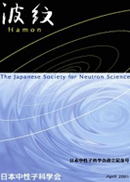
- Issue 4 Pages 166-
- Issue 3 Pages 130-
- Issue 2 Pages 72-
- Issue 1 Pages 3-
- |<
- <
- 1
- >
- >|
-
Masaki Unno, Katsuhiro Kusaka, Taro Tamada, Masakazu Sugishima, Kei Wa ...2016Volume 26Issue 3 Pages 130-134
Published: 2016
Released on J-STAGE: November 14, 2018
JOURNAL FREE ACCESSPhycocyanobilin:ferredoxin oxidoreductase (PcyA) catalyzes the conversion of biliverdin (BV) to phycocyanobilin, a light harvesting pigment. This reaction consists of two sequential steps using two electrons and two protons in each step. Knowing the protonation states of the substrate BV and its surrounding residues is important to understand this unique reaction mechanism. To visualize the hydrogens (and protons) in this unique enzyme, we conducted neutron crystallography of the PcyA-BV complex. In the enzyme, BV bound to PcyA was in equilibrium between the neutral (BV) and the protonated (BVH+) forms. Both of the structures including the hydrogen atoms could be determined. The protonation of the nearby essential residue Asp105 was complemented with the BV protonation states. His88, an essential residue, was protonated to form a hydrogen bond to a lactam oxygen of the BV A-ring. His88 is also hydrogen-bonded to His74 via a hydronium ion. In this article, we also describe the story to grow the large crystals of the PcyA-BV complex and its neutron diffraction experiment.
View full abstractDownload PDF (564K) -
-Analysis of Hydration Structure and Dynamics by Neutron and X-ray Scattering-Tatsuhito Matsuo, Satoru Fujiwara2016Volume 26Issue 3 Pages 135-138
Published: 2016
Released on J-STAGE: November 14, 2018
JOURNAL FREE ACCESSHydration water is essential for protein functions. Characterization of structural and dynamical properties of hydration water is thus important to understand the mechanisms of protein functions. Here, we review our recent studies on the hydration structure (density of hydration water) and the dynamics of hydration water around F-actin and myosin subfragment-1 (S1), which are the partner proteins involved in various cell functions. The density of hydration water was studied by the combined analysis of small-angle neutron and x-ray scattering. The picosecond dynamics of hydration water was investigated by quasielastic neutron scattering. We found that there are significant differences in both the density and mobility of hydration water between F-actin and S1. In particular, the hydration water of F-actin shows different properties from those of the proteins studied so far. Our results suggest diversity in the structural and dynamical properties of hydration water around proteins.
View full abstractDownload PDF (757K) -
Akihiko Nakamura, Takuya Ishida, Katsuhiro Kusaka, Ichiro Tanaka, Nobu ...2016Volume 26Issue 3 Pages 139-142
Published: 2016
Released on J-STAGE: November 14, 2018
JOURNAL FREE ACCESSThe reaction mechanism of a cellulase PcCel45A was revealed by a joint analysis of X-ray and Neutron crystallography. Asn92 residue, which is estimated as the general base residue, showed imidic acid form. In the diffraction map of neutron, the carbonyl oxygen of side chain of Asn92 was protonated and stabilized by the proton pathway. Furthermore, the proton pathway connected the Asn92 and general acid residue (Asp114) by the main chain amides and side chains hydroxyl and amide groups. This result means that de-protonation and activation of water molecule by Asn92 is coupled with the protonation of oxygen atom of glycoside bond by Asp114. In addition, the regeneration of catalytic residues can be achieved by the protonation of Asp114 and reverse proton relay.
View full abstractDownload PDF (708K)
- |<
- <
- 1
- >
- >|